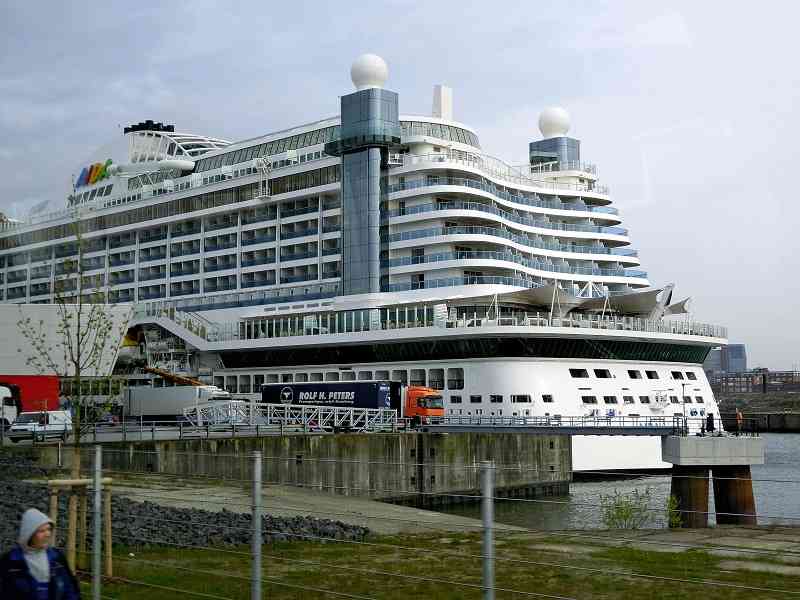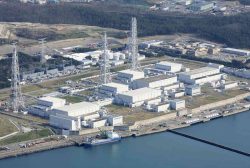
AIDAprima unveiled in Hamburg, Germany, in April 2016
12:27 JST, April 2, 2021
On April 29, 2016, then Mitsubishi Heavy Industries Ltd. (MHI) President Shunichi Miyanaga was in Hamburg, Germany, to unveil the AIDAprima, one of two cruise ships ordered by a U.S. cruise company in 2011.
The huge ship was equipped with swimming pools, an authentic sauna and even an on-board brewery that makes beer out of seawater. Surrounded by guests, Miyanaga was satisfied and said: “There were ups and downs, but it turned out well. I think it’s the most technologically advanced ship in the world.”
Far from a success story, this was a series of hardships.
For starters, the cruise ships were MHI’s first order for large passenger vessels in about 10 years. The company had to place orders repeatedly for parts for the ship’s interiors and wifi connections, because they did not meet the client’s demand. As a result, the delivery date was postponed three times, and labor costs escalated. A fire also broke out during construction. In the end, MHI suffered a total loss of ¥250 billion for construction of the two ships.
Asked why it took so long to build it, Miyanaga, now 72, said, “I can’t deny that we weren’t quite understanding [the level of demand from foreign companies].”
Since MHI could not afford another huge loss, six months later in October 2016, Miyanaga announced the company’s de facto withdrawal from the large passenger ship business.
Selling Nagasaki plant
Shipbuilding is MHI’s founding business. In 1884, Yataro Iwasaki took a lease out on the Nagasaki Shipyard owned by the industry ministry of the Meiji government and started the business.
The company had built 5,400 ships in total, including the Tenyo Maru luxury cruise ship in 1908 at the time of the opening of the trans-Pacific line, the battleship Musashi in 1942 and Japan’s first container carrier, Hakone Maru, in 1968.
In recent years, however, the company’s presence has declined due to price competition with Chinese and South Korean companies in large tankers and container manufacturing. MHI has also fallen far behind its Japanese rivals, which have repeatedly restructured their operations.
In Japan, MHI boasted at the top in the total weight of ships it constructed, with about 1.56 million tons in 2000. However, in 2020 it came in at 14th with about 180,000 tons, which is less than 10% of about 2.69 million tons built by Japan Marine United Corp., a company established with IHI Corp.’s shipbuilding division, Hitachi Zosen Corp., NKK among others as its parents.
The decline in orders has forced MHI to cut production capacity. So MHI is in the process of selling the Koyagi Plant at Nagasaki Shipyard & Machinery Works, which has one of the largest construction docks in Japan with a length of 990 meters. The number of workers — which was more than 2,000 in 2011 — has fallen by more than half.
Problem solving
How can MHI recover from its damaged family business?
“Assembling ships alone can’t beat China and South Korea in terms of cost,” said Toru Kitamura, 60, president of MHI’s subsidiary Mitsubishi Shipbuilding Co. established in January 2018. “We will go forward with an ocean-based solution business.”
The company will boost sales of its systems that efficiently deliver liquefied natural gas to ship’s engines and systems to remove sulfur oxides from ship exhaust.
It also aims to establish a technology to transport liquefied carbon dioxide by ship and eventually develop ships that use ammonia and hydrogen, which emit no CO2, as fuels.
In doing so, the company will make full use of MHI group’s technologies. It envisions the same environmental technologies used on land being utilized at sea.
In recent years, Kitamura has said on his New Year’s cards that his company is “at a major turning point.”
“This is the dawn of the new shipbuilding industry,” said Kitamura. “There are still few rivals in taking an environmental approach. We want to lead the Japanese shipbuilding industry with technology.”
All it needs to do is to realize this vision. Otherwise, the company’s future will be even tougher.
"Business" POPULAR ARTICLE
-

Tokyo Economic Security Forum to Hold Inaugural Meeting Amid Tense Global Environment
-

Keidanren Chairman Yoshinobu Tsutsui Visits Kashiwazaki-Kariwa Nuclear Power Plant; Inspects New Emergency Safety System
-

Imports of Rare Earths from China Facing Delays, May Be Caused by Deterioration of Japan-China Relations
-

University of Tokyo Professor Discusses Japanese Economic Security in Interview Ahead of Forum
-

Japan Pulls out of Vietnam Nuclear Project, Complicating Hanoi’s Power Plans
JN ACCESS RANKING
-

Tokyo Economic Security Forum to Hold Inaugural Meeting Amid Tense Global Environment
-

Keidanren Chairman Yoshinobu Tsutsui Visits Kashiwazaki-Kariwa Nuclear Power Plant; Inspects New Emergency Safety System
-

Imports of Rare Earths from China Facing Delays, May Be Caused by Deterioration of Japan-China Relations
-

University of Tokyo Professor Discusses Japanese Economic Security in Interview Ahead of Forum
-

Japan Pulls out of Vietnam Nuclear Project, Complicating Hanoi’s Power Plans




























